Sempervivum - growing and care.
A work in progress!
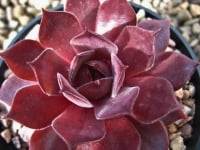
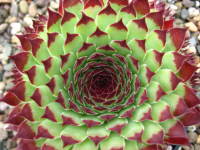
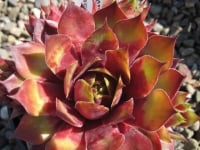
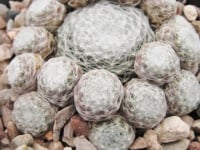
- Where to grow them
- Shapes, sizes, colours and cobwebs
- Flowering
- Buying plants
- Why choose named varieties
- Why we sell growing plants, still in their pots
- Potting compost recommendations
- Our compost recipe - make your own!
- Planting in containers
- Labelling your plants
- Pests and diseases
- Propagation - increase your stock
- Winter care
Sempervivum, or 'Semps' as we call them (or Houseleeks, Hens and Chicks and a host of other names), grow as leaves clustered together in rosettes; each of these rosettes will produce 'baby' rosettes (the chicks huddled around the mother hen) and all will grow together to form handsome clumps. As succulent plants, they excel in hot, dry conditions and need very little in the way of feeding or care - the name Houseleek derives from when they were commonly grown on house roofs when they were believed to ward off evil spirits or as protection from lightning. A collection of different varieties grown together with all their different shapes and colours makes a stunning display.
Where to grow them
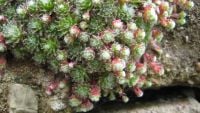 Sempervivum are natives to the mountains so are tough, undemanding plants and do very well growing on rock gardens and rockeries, on stone walls and on small rock features, stone troughs, shed roofs - practically anywhere sunny with good drainage. They will thrive in many situations where most other plants would fail.
Sempervivum are natives to the mountains so are tough, undemanding plants and do very well growing on rock gardens and rockeries, on stone walls and on small rock features, stone troughs, shed roofs - practically anywhere sunny with good drainage. They will thrive in many situations where most other plants would fail.
All Semps will grow supremely well in containers of any type and even large collections can be grown in relatively small spaces. A collection of varieties grown in old clay, terracotta pots is a classic feature. Only a balcony or small yard? No problem! Horrible soil or even no soil - no problem! You love plants but just can't devote a lot of time to growing them? - no problem! Semps need minimal care and very little watering. You can go on holiday for two weeks of a hot summer (doesn't the weather at home often turn nicer when you go away?!) but your Semps will be still be alive and thriving on your return.
Shapes, sizes, colours and cobwebs
Semp leaves are ever-changing in colour - some start the year green, become intense red or purple, then change again as winter approaches - these ever-changing colours are a major attraction of houseleeks. Leaf colour not only varies according to season but also with rainfall, amount of light, temperature and nutrition.
 In some varieties, the rosettes have a covering of fine hairs (cobwebbing) especially in drier conditions and others have fine hairs on the edges or tips of the leaves. These tiny hairs (cilia) can give the leaves silver edges or cover the entire leaf making the entire plant appear silver. Many forms show amazing symmetry in the shape of their rosettes. These plants offer so much!
In some varieties, the rosettes have a covering of fine hairs (cobwebbing) especially in drier conditions and others have fine hairs on the edges or tips of the leaves. These tiny hairs (cilia) can give the leaves silver edges or cover the entire leaf making the entire plant appear silver. Many forms show amazing symmetry in the shape of their rosettes. These plants offer so much!
As well as ever-changing colors, the plants come in a wide range of shapes and sizes - from large growers with broad leaves, to ones with tiny leaves clustered so tightly they form very neat little mounds. Individual rosettes can be as large as a plate or as small as a finger nail.
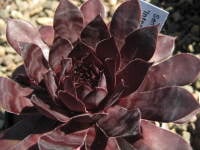 Some varieties show what are known as water marks - these are horizontal or wavy bands across the leaves as if the leaf tip had been dipped in water dye. Think of the 1970s fashion for tie-dyed clothes. This photo of 'Intensity' shows the water marks especially well on the dark leaves. Not all varieties will show water marks but they are often prized if they do. Water marks only normally appear with summer growth, if they appear at all, but they are an often over-looked attraction. Once you recognise them, you'll start looking for them.
Some varieties show what are known as water marks - these are horizontal or wavy bands across the leaves as if the leaf tip had been dipped in water dye. Think of the 1970s fashion for tie-dyed clothes. This photo of 'Intensity' shows the water marks especially well on the dark leaves. Not all varieties will show water marks but they are often prized if they do. Water marks only normally appear with summer growth, if they appear at all, but they are an often over-looked attraction. Once you recognise them, you'll start looking for them.
Flowering
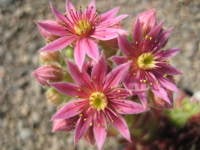 Most Semps will flower at some stage, depending on variety. Some flowers are very beautiful and bright, others are fairly dull and not as pretty as the leaves. The cobwebbed types (or those with cobweb genes in them) are always worth seeing in flower. The flowers are usually pink or some shade of pink to almost red, some are yellow and a few are white.
Most Semps will flower at some stage, depending on variety. Some flowers are very beautiful and bright, others are fairly dull and not as pretty as the leaves. The cobwebbed types (or those with cobweb genes in them) are always worth seeing in flower. The flowers are usually pink or some shade of pink to almost red, some are yellow and a few are white.
It is important to understand about their flowering habits - technically, they are known as monocarpic - they flower and seed only once, then they die. But only that one rosette, not the whole plant! After a year or two, maybe more, a mature rosette (often the central rosette in a clump) will start to change. The colour may change and the rosette will start growing upwards - this is the flower stalk. This early stage is sometimes called 'coning' as the rosette takes on a cone shape. These flowering rosettes don't usually develop offsets or chicks.
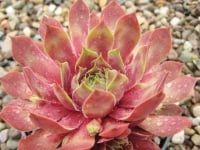
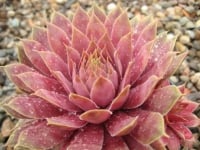
You can see this starting on one of these two images of 'Fuego', both taken in June. The two plants were potted at the same time but obviously the one on the right was a more mature rosette and is starting to flower. You can clearly see the change of colour and the cone shape developing. If you notice on the right picture (at about the 4 o'clock position) there is a non-flowering rosette peaking out.
You may remove a flowering rosette as soon you see it or soon after flowering (my preference) or let nature take its course. Once removed or flowering has passed, the stalk will leave a gap in the plant, often spoiling a clump of lovely rosettes. Fear not, Semps root easily, so take younger rosettes and simply replant them in the gap - it’s that easy! A small amount of fresh compost or grit might help raise them up and help them grow more quickly. The smaller cobwebbed varieties don't leave gaps, their stems just seem to wither and new rosettes will fill their space. Most flowering Semps set huge amounts of seeds - just be aware that if left alone, random seedlings will appear among your treasured named ones. This is generally a 'bad thing', which is why I recommend removing flower stalks soon after flowering, before seeds set.
Another very important point about the flowering habits of Semps means you should be wary of buying plants with only a single rosette - if that one flowers, you will be left with nothing. Young rosettes don't flower but older ones might, so be wary when getting single rosettes as there is little you can do to prevent flowering. Any kind of stress can induce flowering, such as being dried out (as they often are before posting bare-rooted), high temperatures and strong sunshine. Some years just seem to be worse than others. Like the 'Fuego' on the right above, the flowering rosette will die after flowering but that little one peaking out will continue growing, so you wouldn't lose the whole plant. Losing your only plant of a variety is a collector's worst fear!
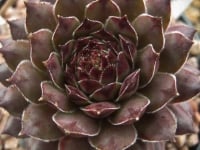
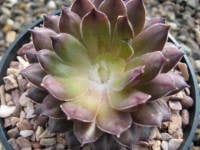 So what can be done? You can't really stop a plant from flowering but there is one thing you can do. It looks drastic, and it is. But remember the rosette will die after flowering anyway, so what's to lose? On the left is a flowering rosette of 'Tristesse' and on the right, after 'the treatment' - cutting out the flower stalk as low as possible. This only sometimes works, but again, what's to lose?
So what can be done? You can't really stop a plant from flowering but there is one thing you can do. It looks drastic, and it is. But remember the rosette will die after flowering anyway, so what's to lose? On the left is a flowering rosette of 'Tristesse' and on the right, after 'the treatment' - cutting out the flower stalk as low as possible. This only sometimes works, but again, what's to lose?
You might be lucky and shock the poor plant into resuming vegetative growth, in which case you may just be rewarded with a new, non-flowering rosette or two, enough to save the plant or variety. You must take out the flower shoot as low as possible though. If you cut it too high you will soon see what look like new rosettes forming - great excitement! Most often these only turn out to be yet more flower shoots - great sadness : (
When we send out plants to customers we almost always send out more than one rosette in a pot anyway, often several, except where we are certain it is a young, non-flowering age rosette. This leads us on nicely to buying plants.
Buying plants
Sempervivum can be found in many places - garden centres, market stalls, DIY stores, car boot sales and online auction sites to name a few. But because Semps are so easily grown, they do tend to be somewhat abused - grown too quickly, over-protected, over-fed, not given enough light and grown in poor (usually peat-based) compost. They might be named, maybe not, and too often named incorrectly.
Many places want to sell small plug plants, usually grown too quickly and dubiously named, if named at all. You commonly find plants like this on the auction sites and online market places and often at over-inflated prices. These plants will recover and may well grow away, such is the tolerance of Sempervivums. They could be so much better with only a little extra care and knowledge. But then, I've spent all my adult life growing plants - and a good part of my childhood too! Such un-named plants (raised from mixed seed) may be perfectly acceptable if all you want is plants to fill a particular space or purpose. However, these seed-raised plants simply won't offer the colours and shapes of named varieties. With a name, you know what to expect, more or less.
Why choose named varieties?
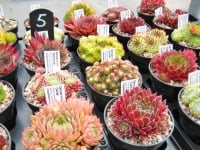 There is a world of difference between what is commonly offered from the sources mentioned above (often unnamed or incorrectly named) and what specialist growers such as ourselves offer. We only grow named varieties - to be botanically correct, we should call them called cultivars, culti-vated var-ieties, but the terms varieties and cultivars are commonly used interchangeably. These varieties (okay, cultivars!) which have been specially bred and selected for special attributes - colour, shape etc. and then named. We maintain these varieties year after year by propagating the plants from offsets (the babies or chicks) so that they remain true. Seed raised plants might be attractive enough but every one will be different and comparatively unexciting. Most breeder of new cultivars will start plants from seed (often from carefully selected parents) but even they will sift through and discard the vast majority of seedling before selecting something special, if something appears. If you like these seed-raised plants, great, nothing wrong with that, but if you really want to enjoy the brighter colours etc., then named varieties are what you want. And to be accurately named they must come from a reliable source - misnamed plants are sadly all too common. If they aren't named, who knows what you are buying? If they are cheap plants it doesn't matter so much, but if you pay good money .....
There is a world of difference between what is commonly offered from the sources mentioned above (often unnamed or incorrectly named) and what specialist growers such as ourselves offer. We only grow named varieties - to be botanically correct, we should call them called cultivars, culti-vated var-ieties, but the terms varieties and cultivars are commonly used interchangeably. These varieties (okay, cultivars!) which have been specially bred and selected for special attributes - colour, shape etc. and then named. We maintain these varieties year after year by propagating the plants from offsets (the babies or chicks) so that they remain true. Seed raised plants might be attractive enough but every one will be different and comparatively unexciting. Most breeder of new cultivars will start plants from seed (often from carefully selected parents) but even they will sift through and discard the vast majority of seedling before selecting something special, if something appears. If you like these seed-raised plants, great, nothing wrong with that, but if you really want to enjoy the brighter colours etc., then named varieties are what you want. And to be accurately named they must come from a reliable source - misnamed plants are sadly all too common. If they aren't named, who knows what you are buying? If they are cheap plants it doesn't matter so much, but if you pay good money .....
Why we like selling growing plants, still in their pots.
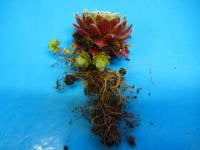 Some nurseries offer Sempervivum as dry plants with soil and roots removed - in fact, this is the way most enthusiasts exchange plants so there is nothing really wrong with this. But, the plants do need time to recover and start growing again and they need prompt handling on receipt and some degree of care.
Some nurseries offer Sempervivum as dry plants with soil and roots removed - in fact, this is the way most enthusiasts exchange plants so there is nothing really wrong with this. But, the plants do need time to recover and start growing again and they need prompt handling on receipt and some degree of care.
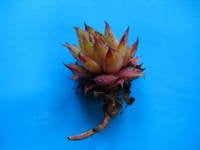 It's not uncommon to be offered unrooted rosettes either. These are photos are of actual 'plants' I have bought in the past - I was happy to receive these as they were varieties we really wanted. But they weren't cheap and took a whole season to get to any size. Our plants are usually at least a year old before we sell them. I was 'happy' to take the risk that the single one wouldn't soon run to flower then die. It can be a desparate business building a collection!
It's not uncommon to be offered unrooted rosettes either. These are photos are of actual 'plants' I have bought in the past - I was happy to receive these as they were varieties we really wanted. But they weren't cheap and took a whole season to get to any size. Our plants are usually at least a year old before we sell them. I was 'happy' to take the risk that the single one wouldn't soon run to flower then die. It can be a desparate business building a collection!
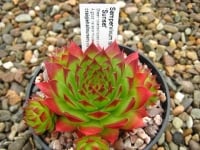 We prefer to offer properly grown, established plants, showing their best colour and offering the quickest possible growth when planted up. Very often you will receive a good group of several rosettes growing in each pot - depending on variety and season of course - so our plants are fantastic value. We pack our growing plants with extreme care so that they arrive with you in near perfect condition. This is quite time-consuming but we're very well practised, having grown and packed many, many thousands of plants over the years. They should arrive with you just as they are pictured here - plant, pot, label, even the grit should still be in place! And all of our packaging is reused, recyclable or compostable material, not plastic or bubblewrap.
We prefer to offer properly grown, established plants, showing their best colour and offering the quickest possible growth when planted up. Very often you will receive a good group of several rosettes growing in each pot - depending on variety and season of course - so our plants are fantastic value. We pack our growing plants with extreme care so that they arrive with you in near perfect condition. This is quite time-consuming but we're very well practised, having grown and packed many, many thousands of plants over the years. They should arrive with you just as they are pictured here - plant, pot, label, even the grit should still be in place! And all of our packaging is reused, recyclable or compostable material, not plastic or bubblewrap.
You may be wondering how we can offer superior plants at value prices. We are professional growers - we use our skill and experience to produce the best plants we possibly can and sell them at reasonable prices to make our living. We could charge more - there is at least £12 worth of offsets on this 'Sunset' plant for some people and no doubt we would sell some at that price - but we wouldn't sell enough to make a living, it's as simple as that. We need to grow and sell an awful lot of plants to make any kind of living. Here is just some of our annual output.
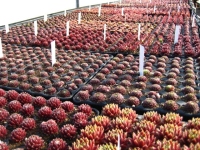
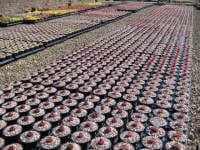
Potting compost recommendations
Another reason we can offer pot grown plants is because we use the highest quality compost which we insist on making ourselves. Basically, it's a mix of coir, bark, sand, grit and Perlite (an expanded volcanic rock) with added lime and fertilisers. It also contains loam (or soil), the 'magic' ingredient - invented by Mother Nature and used by her the world over! We prepare and sterilise this loam ourselves to make sure it doesn't contain troublesome weeds or harmful diseases. It's hard, heavy work, and slightly unpleasant, but the product would be too expensive to buy - even if we could get the same quality. Is it worth it? Absolutely! Does anyone care? I don't know, a few maybe, but I know in my heart it's the best I can get and offers so much more than some general purpose, peat-based compost most commonly used.
So what is wrong with peat compost? Environmental concerns aside, nothing! But it really doesn't suit Sempervivums - it holds too much water and contains too much fertiliser, both major disadvantages. It works supremely well for most other plants though and the peat-free alternatives, whilst good, have similar drawbacks.
So just how is our compost different? Well, the plants grow differently, slower, more like their true character in colour and shape. The sand, grit and Perlite (and the coir and bark too) all offer good drainage - when you water our plants you will see the water disappears instantly. The compost holds enough to keep the plants growing but not too much, one of the vital 'secrets' to growing Semps well. The loam also allows the plants to grow and obtain nutrition and minerals in the longer term - something peat-based composts are extremely poor at.
Imagine a pot of peat-based compost planted out in garden soil - it forms a plug of water-retentive peat right at the base of the plant which is often fatal to succulents like Semps. Peat (and even the best of peat substitutes) doesn't blend or associate with the natural soil at all. It's easy to see in a peat-grown plant that they develop a different type of root system to that of a soil-grown plant and there is plenty of anecdotal evidence (if not scientific) for some plants resenting the transition from growing in peat to growing in soil. For many plants such as bedding plants, vigorous shrubs or vegetables, none of this matters and peat composts (or substitutes) have many advantages, but these mixes don't suit Semps. Yes, they will grow in it, but it's just not right or best for them. Those are my beliefs so I'll keep making my own compost. And I'll give you a similar recipe if you would like to use it for planting your own pots or containers.
Our compost recipe
Our compost recipe only needs three ingredients. Mix these together using equal amounts of each.
- Coarse grit - gives good drainage and stops the compost retaining too much water.
- Ready made potting compost which you can buy, not garden compost. We like the peat-free alternatives.
- Good garden soil.
The ready made compost you can find almost anywhere. The actual type isn't too important as it will be diluted with the other ingredients. The garden soil is the crucial part. Soil can hold nutrients and minerals then release them slowly over an extended period in a way that peat composts simply can't.
Use the best garden soil you have, as weed-free as possible and certainly with no dandelion roots or stones etc. It will contain weed seeds (unless you can find sterilised topsoil) but they're a minor inconvenience. If your soil happens to be heavy clay, increase the grit content/reduce the soil. If your soil is very rich in organic matter, reduce the compost etc. Adding extra grit is always better - it's easy to add water or feed to compost but we can't remove excess water - more grit means better drainage.
You won't need to add fertiliser to your new mix as there will be sufficient in the soil and the ready made compost to last the plants into the following year. Don't get too hung-up about lime and pH or it being too acidic as Sempervivum are quite tolerant. If you already know your garden soil tends to be acidic, by all means add some garden lime when mixing.
Sharp, angular grit is best, not rounded particles, and the size isn't too important. 5 to 6mm (¼") grit is a good size. Builders' merchants are often a good source, as are DIY places and in the USA, chicken grit is often used. Small gravel (less than 10mm) will do, but not pea gravel as that is too rounded. Coarse sand will do too but often has too many fine particles among the coarser ones.
Perlite, as I mentioned before, is an expanded volcanic rock produced under high temperatures. This makes it totally sterile and it's pH neutral (neither acid or alkaline) but it does have very useful physical properties. Perlite holds some water in its tiny pores but it also holds a high proportion of air, even when saturated. For Sempervivum, this gives compost that won't hold as much water and also holds a lot of air (roots need to breathe too).
Perlite is also very lightweight so that means a compost containing Perlite won't be so heavy for moving pots around. It's a magical, wonder-material! But you'll have guessed the drawback - it costs much, much more than grit. However, a small percentage in a compost mix can go a long way. It comes in various grades but we use the coarse size (3 to 6mm particles) for maximum effect. Lots of places sell it online in small packs, as well as garden centres etc., but if you can take a 100 litre bag, then specialist horticultural suppliers offer the best deals. You can replace whatever percentage of grit you want to in your own compost mix if you wish. But grit does the job for good drainage too ....
Planting in containers
Growing in pots is an excellent way to grow Semps - some collectors keep huge collections entirely in pots. They look fantastic in old terracotta clay pots especially when grouped together but note that most terracotta will crack in hard frost, so take care in winter unless the pots are sold as Frost Resistant. Any type, size or shape of pot or container can be used as long as there is a hole (or holes) to allow water to drain out. We like a pot at least 13cm (or 5”) in diameter (assuming it’s round, it needn’t be!) for each plant. Or about 1 litre of compost which is an easier measure. We only sell plants which are already growing in their little pots so they should start growing soon after planting.
Always fill pots to the brim - I am on a one-man crusade to eliminate the sight of plants sitting half-sunk below the pot rim. Plant them high and proud, people, high and proud! Try it and see. And if you don't like it, you are a bad person and not a real gardener!!
Labelling your plants
Please note - this is a long section. The shorter version - label your plants and keep them labelled! You may scroll down to the next section if you wish.
Why is labelling important? Well, it’s not, if you only want a few plants to enhance your garden or to fill a few pots. However, if you start a collection, no matter how small you begin, then the correct naming and labeling of the plants is crucial. You might just become a collector without realising it at first! There are numerous cases of misnamed and misidentified plants circulating in the trade and between enthusiasts and we really don’t need any more. A name must refer to only one plant variety (correctly, a cultivar or cult ivated var iety).
In America, they have a useful term - unnamed or unidentified plants are called NOIDs, or No ID, no identification. There is nothing to prevent you growing a NOID or even a selection of NOIDs (most people start this way before they get hooked) but please don’t try to affirm names to them. There are nearly 5,000 named cultivars now and so many are as near identical to others it is impossible to tell them apart. Some varieties are so distinctive they couldn’t really be anything but themselves, but it takes experience to be sure, even when referenced with a huge collection. Even the best experts will struggle to correctly identify a given plant, especially as Semps change so much through a growing season and with environmental changes, as I explained earlier. Anyone (and everyone) growing named Sempervivums needs reliable labels.
 So how best to label your plants? We insert a fresh plastic label with every plant we sell, printed with the correct name, naturally. These labels are made from plastic and whilst fairly robust and durable, they will go yellow and become brittle with exposure to sunlight as plastics do. They can last 3 or 4 years before they need replacing, depending on exposure, but the print will last longer than the label itself.
So how best to label your plants? We insert a fresh plastic label with every plant we sell, printed with the correct name, naturally. These labels are made from plastic and whilst fairly robust and durable, they will go yellow and become brittle with exposure to sunlight as plastics do. They can last 3 or 4 years before they need replacing, depending on exposure, but the print will last longer than the label itself.
A new plastic label clearly handwritten in hard black pencil will last quite well too. Some nurseries, even the best, only write small paper slips as identifiers when they sell plants, so finding a label becomes urgent. The best labels we have found are made from thin aluminium sheet written on with pencil or inscribed with a sharp tool. These last almost indefinitely and are as good as your handwriting. The colour doesn’t offend the eye as much as white plastic either and birds seem less attracted to them. It’s no surprise this is the most expensive solution but these labels can be found at favourable prices on eBay. One interesting tip is that old-style Venetian window blinds are made from aluminium and names scratched into the 'paint' with a sharp tool will last a very long time. Newer blinds tend to be plastic though.
Be creative! I have seen ideas online and thought, ‘that’s clever’. One was the name written on a rounded pebble (about hen egg sized, but flatter) and placed next to the plant. It looked very good and was unobtrusive. You could do the same with small pieces of slate. These labels will last a million years! But you still won't be able to read them once your paint, pen or pencil wear off .....
A good tip for stick-in labels - push the label well down into the pot or the soil around the plant. An old knife makes a good tool for creating a slit to allow the label in past stones etc. When the labels are pushed down well they are less intrusive, harder to dislodge and so less likely to go missing. You will see from the example label above that we have also printed the name near the bottom of the label - if the top of the label goes brittle and gets broken off, becomes illegible etc., you can still find the cultivar name buried down the edge of the pot. It's two labels in one! And if you don't want the labels on show you can cut off the top part (and file it away in your records - we're getting too serious now!!!) and just use the bottom part.
It is best to write the full cultivar name on a label. Abbreviations can be replicated, wrongly. Another thing to be wary of is deliberately translating the name into English from the original language. So 'Rosa Mädchen' (German) becomes 'Pink Girl' in English. This often happens when viewing plants online using a translator - like Google Translate. Sometimes they will show the name correctly, but on the same page translate the name into English. So 'Schwarze Rose' becomes 'Black Rose', then the name 'Black Rose' gets wrongly perpetuated and we soon end up with two identical plants circulating with different names. Worse still, 'Merkur' from Martin Haberer translates as 'Mercury' - but we already have a 'Mercury' from Edward Skrocki. Some names are very similar too - 'Kimble' and 'Kimba', 'Indra' and 'Indre', 'Teddy Bear' and the Dutch version 'Teddy Beer'. It's all just attention to detail.
The plant trade is a guilty as anyone of perpetuating incorrect names, possibly more than any amateur. Some nurseries are very guilty of substituting one variety for another and blatantly sending out plants with a known, incorrect name. Don't think it doesn't happen! And I'll hold my hand up here - it's easy to receive a plant, propagate and innocently distribute it with an incorrect name on the label, even when it comes from a 'reliable' source. And at the end of the day (as they say), we're all human, and genuine mistakes will happen. Can you tell that incorrectly named and labelled plants is a bugbear of mine?!
One final plea - please don’t write labels ‘upsidedown’. With a normal stick-in label, the writing should start by the square end of the label, not at the pointy end. This way, you can read the top of the label or enough letters to jog your memory without needing to pull it out. They never go back in the same, do they? Written the other way (the wrong, up-side-down way) you must pull the label out to read it. Not everyone agrees with me on this, but this is another bugbear of mine from a working life spent among plants. I have a lot of bugbears! Please keep your plants correctly named and labelled. End of sermon.
Pests, diseases and other ailments.
Pests and disease only trouble Semps occasionally. Aphids sometimes attack but a quick spray will see to them - chemical bug sprays if you want but the more natural based sprays will work too. Bottles of 'ready to use' in the squirty trigger guns are ideal. Some people find their plants troubled by root aphids (seen under their wooly covering when repotting plants) but we have never seen them here.
Vine weevil. I can barely type their name! Little, dark grey, beetle-like creatures that lay eggs around all manner of plants, their eggs hatch into little grubs that gnaw at the plants’ roots. Crescent shaped, creamy white in colour with dark heads, the first signs of attack are often of a plant doing poorly. They might have slightly soft or wrinkled leaves (not fat and juicy as normal), especially in hot weather as the chewed roots mean the leaves can't draw moisture from the soil. Then, upon inspection, the whole plant often comes away from its roots.The adult weevils may chew conspicuous notches in the leaves too - a sure sign that they are at least present. The adults only come out at darkness to feed, so go looking at night.
You must destroy the roots and the soil or compost, along with the little offenders too, obviously, but the plant may be rescued (details below). Varieties with large, smooth leaves always seem more prone to attack, the hairy-leaved, cobwebbed ones much less so. Vine weevils are well distributed around the countryside and I've found them on native plants a long way from any garden source. Other types of plants are more prone to attack - grape vines (hence the name), Primulas, Saxifrages and their relatives like Heuchera and Astilbe, strawberries and many others. Chemical controls are available (for now) but are more effective when used as a preventative. Biological controls are available too and these work well but only in the right conditions - they don't work well in cold temperatures. I should say that we don’t currently use any controls for vine weevil but we're ever-vigilant. Or foolhardy! I believe that vine weevils are much more likely to attack (and attack badly) plants grown in peat-base composts. Soil and sand seem to deter them. Thankfully, Sempervivum can at least be rescued in most cases.
Very few diseases will trouble Sempervivum. The usual one (that will attack almost any plant if the conditions suit) is the common Grey Mould or Botrytis. It likes cool, humid conditions but is rarely a problem on outdoor plants where air can circulate. Botrytis is more of a problem with plants grown inside and the 'cure' or prevention is good air circulation. Try not to water over-wintered plants on their leaves, if you water at all. And removing any soft, mushy and discoloured basal leaves can help but you must remove them completely, leaving a piece attached to encourage rot is pointless.
Fungicides are available but I doubt their efficacy, even commercial strength ones are of little use as they can't really reach the heart of the problem, right underneath a clump of rosettes. Good air flow and keep them dry. Another disadvantage of fungicides is that they can mark the leaves terribly - even their residues. I remember when I bought 'Royal Ruby' many years ago (from a garden centre, strangely enough) it was so coated in something, presumably fungicide/pesticide, that I was reluctant to even touch it.
Increasing your stock
Propagating Sempervivum is very easy as I have already mentioned. You may want to rescue a damaged plant (as above), increase you stock of plants or just as backup - a spare plant in a pot can save the disaster of losing a treasured beauty. Semps are fun to share too, and they make lovely gifts even for non-gardeners, especially if you are a bit creative with a nice or novel container. It's not in my interest to say it, but exchanging plants you have propagated yourself with other enthusiasts is a good way to obtain new cultivars. Finding fellow enthusiasts might be harder than finding new plants though - we're very niche! I don't know what happens on Facebook though as I don't go there, but I believe there are groups for everything. It may be there are Semp growers too, tucked away in a quiet corner ......
Anyway, how to propagate. It's very simple - take off a young rosette (a 'baby' or chick) from the outside of the mother plant and place it on some good soil or compost. This is best done in late spring, summer, or through to early autumn at the latest. You may well find some fresh little roots already formed when you pluck the rosette from its mother so it's guaranteed to grow already. Some people say remove the stalk from the rosette so that new roots come directly from the base - I'm not convinced it matters much. Water it gently and keep it out of strong sunshine. And that's it! If you planted the rosette in a small pot, don't over-water it, try to let it dry out between waterings. Older rosettes can be used if you really must, but fresh, young rosettes have more natural vigour and make better plants. And if the plant has a name - label it!
Winter care
There is one golden rule here - Semps don't like excessive wetness. Rain won't harm them but excessive rain and/or humid conditions might. I don't want to exaggerate this point as these are mountain plants, perfectly hardy and generally tough, but in our lowland gardens, dampness is something to look out for. We can grow Sempervivums outside here in cold, wet Scotland, but we need to be careful with some varieties in some conditions. A foggy, damp November is a time of worry! Areas having very high rainfall are always more challenging.
The natural growth sequence of a rosette is to swell and grow over spring and summer. As autumn progresses, the lower, outer leaves may start to yellow and die and the inner leaves may tend to curl in on themselves. The whole plant might appear to shrink but that's just what happens. The only thing to be aware of is that - again, under moist conditions - the dying leaves might start to rot. Various fungal diseases thrive in humid conditions, Botrytis or Grey Mould being the most common. This is a special danger of over-protecting the plants.The plants need the wind around them to help them dry off between the rainy days and to keep the leaves hard and tough so they don't attract disease in the first place. The final point I'm going to make here is that it sometimes helps to keep the plants 'clean' - carefully remove those dying leaves from the bottom of the plants, especially if the leaves tend to be mushy. If they are hard and crispy - great! - leave them alone.
Bear in mind our experience is of growing plants to sell - we want (need) them to look good when you receive them, not just alive and clinging to life. Protected plants always look more appealing early in the season. Most people probably have no trouble with any of their plants, but the further north and/or west you live means you might need to take more care. Proper soil preparation, grit around the plants and good compost all become more important.
When planted in the garden you will have already chosen a sunny, free-draining spot so the plants will take their chance and should be fine. Many enthusiasts will move pot-grown plants somewhere drier for winter, even the relative shelter of the house wall can help keep off the worst of the rain. But the plants still need air around them and the best light, this is vital. Even the most severe cold and frost won’t harm them though, so long as they aren’t too wet.
One thing that can harm Semps is hail and a 60 second hail shower can render plant leaves pock-marked with brown spots. It's unsightly, but it will pass. Large-leaved, smooth varieties are more prone to hail marking, the furry-leaved, cobwebbed ones rarely suffer as the tiny hairs cushion or protect the plants. Strangely enough, watering your plants as soon as hail starts can reduce the damage as the droplets or film of water can offer just enough protection. Summer hail is less common but more damaging than winter or early spring hail as the plants are naturally softer in summer.
Some lucky enthusiasts have a greenhouse where they can enjoy their plants but that is a luxury, not a necessity. Maximum ventilation is essential at all times (especially in winter) so Semps don't share well with other plants in a greenhouse. A simple old-fashioned cold frame does the same job as a glasshouse for the plants, if not for the human. A cold porch could be used or even a pane of glass or Perspex angled against a wall to shed the worst of the rain. In all cases, ensure good ventilation. Poly tunnels are the poor person’s greenhouse (we use them!) but maximum ventilation is even more crucial to prevent any build-up of humidity. This is the major disadvantage of polythene and the dripping condensation that often occurs. Your little treasures will turn to a furry, mouldy mess in no time if they get too humid, especially over winter. No heating is needed anywhere, ever - keep them cold. We have had -20°C here several times in the past, and lower.
It is always a good idea to take a rosette or two from treasured plants in late summer and pot them up as insurance against losing them completely - whether through weather, pests or accidents. It is so easy to do and takes up so little space, it seems foolhardy not to. With minimal attention you could easily keep your Sempervivum collection for the rest of your life. And all from a plant that costs the same as a takeaway coffee! What amazing plants! What amazing value!!
Jovibarba
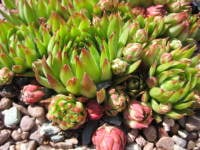 What are Jovibarba? Jovibarba - or Jovi's - are plants closely related to Sempervivum. In fact, the botanists now insist that they are a species of Sempervivum, but old names die slowly and gardeners, growers and publications take time to catch up. There are two common species of Jovibarba (now Sempervivum). The first is Jovibarba globiferum, and these are commonly known as 'rollers'. They look much like any Sempervivum but the young offsets are only carried on very weak shoots (or stolons). The young offsets break off easily and roll away, hence 'rollers', like the red ones on this photo. There are many natural forms of this species and all are easy to grow.
What are Jovibarba? Jovibarba - or Jovi's - are plants closely related to Sempervivum. In fact, the botanists now insist that they are a species of Sempervivum, but old names die slowly and gardeners, growers and publications take time to catch up. There are two common species of Jovibarba (now Sempervivum). The first is Jovibarba globiferum, and these are commonly known as 'rollers'. They look much like any Sempervivum but the young offsets are only carried on very weak shoots (or stolons). The young offsets break off easily and roll away, hence 'rollers', like the red ones on this photo. There are many natural forms of this species and all are easy to grow.
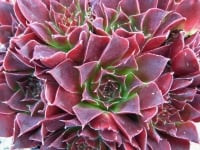 The other common species is Jovibarba (Sempervivum) heuffelii - pronounced hoo-fell-eh-aye with the stress on 'fell'. They are known as 'heuffs' by collectors and are commonly thought of as the elite of the Sempervivum world. They too are similar to normal Semp cultivars but they increase differently - the clumps of rosettes divide themselves, not by sending out babies or offsets on shoots like most Semps do. To propagate these Jovi's, we must physically cut the clumps apart with a sharp knife and separate each rosette from its neighbours, then encourage it to make roots. With this plant of 'Bora' pictured here, it would probably split into 6 or 7 new plants but the original has taken at least 3 years to get to this size. The chances of infection (and failure) are obviously much higher and It's not as quick or easy as plucking off a rosette from a normal Semp. These things only increase their rarity value.
The other common species is Jovibarba (Sempervivum) heuffelii - pronounced hoo-fell-eh-aye with the stress on 'fell'. They are known as 'heuffs' by collectors and are commonly thought of as the elite of the Sempervivum world. They too are similar to normal Semp cultivars but they increase differently - the clumps of rosettes divide themselves, not by sending out babies or offsets on shoots like most Semps do. To propagate these Jovi's, we must physically cut the clumps apart with a sharp knife and separate each rosette from its neighbours, then encourage it to make roots. With this plant of 'Bora' pictured here, it would probably split into 6 or 7 new plants but the original has taken at least 3 years to get to this size. The chances of infection (and failure) are obviously much higher and It's not as quick or easy as plucking off a rosette from a normal Semp. These things only increase their rarity value.
The growth of 'heuffs' makes them very desirable too. They are very compact and slow-growing and generally more weather resistant than most Semps. There are many named cultivars and they come with leaves in every shade of green, red, pink, purple and almost black, much like Semp cultivars. And then there are the silver edged leaves, contrasting colours and shapes etc. Their flowers are attractive too, more bell-like than the starry flowers of Semps and most commonly yellow. The 'heuffs' are often thought of as only for the conoisseur, and yet they needn't be, as they are very easy to grow with the same needs as any Semp. Finding them may not be easy though. We have a small range we hope to offer in the future.
Companion Plants and other succulents
The growing conditions enjoyed by Semps are also loved by their relations, mainly those from the Crassula family, but other succulent and drought-resistant plants too. (to complete)
Sedums are one the largest groups although the botanists have renamed many of those too (now Hylotelephium).
Delosperma, Ectotropis, Lewisia, Crassula, Rhodiola, Mesembryanthemum .....
Recommended books
There aren't many books specifically on Sempervivum although they usually get a short mention in general books on alpine plants. A few books were published many years ago, now out of print, but may still be available second hand.
The best and most up to date reference is a 2018 book by American breeder Kevin C. Vaughn, Sempervivum - A Gardener's Perspective of the Not-so-Humble Hens-and Chicks. I thoroughly recommend it. However, there is also a wealth of information online that will be published in print so here follows some of my favourite sites.
Links to other websites
Sempervivum-liste.de This is the probably the most important site for Sempervivum and Jovibarba in Europe. Crammed full of information and pictures, and most importantly, a de-facto compendium of all known cultivars.
The National Gardening Association (of America) has this wonderful resource, similar in many ways to the above but with an North AMerican slant. It's often worth searching for information on varieties that were bred or are popular stateside. They also have an active Hens and Chooks forum with some very knowledgable experts contributing.
The nursery website of Erwin Geiger in Germany. Drool away! Tip - use Google translate (or similar), just be aware that it may also translate plant cultivar names into English which is not a good thing.
Volkmar Schara's nursery website. Another talented German breeder.
Kallima Gardens in Slovakia is a nice site with good images. I can't provide a link, you'll need to search for it). With translate, look for Rock Roses. Not what we might call Rock Roses (Helianthemum) but that's what you need to look for.
Here is a link to fascinating website (edit, sorry, link appears to be broken) by an enthusiast who has compiled so much information. You must watch the video (YouTube link) about Semp breeder Ed Skrocki! This was taken from when he appeared on the US tv show 'A Gardener's Diary'.
Here is an article in Cactus and Succulent Review, March 2021. The link takes you to a PDF download.
Breeders
Georg Arends first started specifically breeding Sempervivum nearly 100 years ago in Germany and many developments have taken place. Every breeder who establishes a new cultivar then potentially provides a base for further breeding so a plant with a black tint to the leaves becomes darker and darker with each attempt. Well, in theory - you have to kiss a lot of frogs! We now have several wonderful cultivars that anyone would say are as close to black as we may get. But black isn't everyone's thing, so we have (and had) breeders who favour red leaves, or cobwebs, yellow leaves or nothing in particular, always looking for the different and the unusual.
It is incredibly difficult to select a few breeders from a huge list but here are some of my favourites.
Sue Thomas is a UK breeder who, since around 1999, has given us many wonderful cultivars and her plants are in great demand, especially in Europe. Sue seems able to create varieties that offer just that something different. Some of her stand out varieties for me are the black 'Intensity', the multi-coloured delight, 'Foxy Lady' and the little 'Sea Coral'.
André Smits from Belgium is an incredibly prolific breeder - he must have raised many hundreds of varieties. He gave us the wonderful cobwebbed 'Koko Flanel' and 'Boule de Neige'. 'Terracotta Baby', 'Aladdin' and 'Tip Top' are also his and we do very well them. André has so many varieties that some are still little known - plants like 'Harriet', 'Albisoca' and 'Mavina'.
Volkmar Schara is relatively young but has already named over a hundred varieties. All of his plants are good but some are outstanding. 'Leopold' (named for his son) is a fantastic plant with large black leaves and 'Dr. Fritz Köhlein', a gorgeous red and creamy-yellow bicolor. Volkmar runs a successful Sempervivum nursery in Germany.
Martin Haberer was at his most prolific in the 1970s and 80s but continued into the 2000s and only gave up his collection in March 2018 (I presume) due to old age. Martin gave us 'Bronco', probably one of the best Semps ever and it has won many awards. Many of his plants are little known in the UK but 'Cono', 'Aline', 'El Misti' and 'Irazu' show us some of the depth of his breeding and the award-winning 'Fuego', 'Reinhard' and 'Sioux' the quality.
David T. Ford (UK) was a true Semp enthusiast and breeder who left us so many varieties that we feel are as good as any, old or new - 'Red Spider', 'Dyke, 'Black Mini', 'Red Ace', 'Corsair', 'Gay Jester' and 'Hart' to name a few.
Erwin Geiger is another German nurseryman who is still relatively young. I like his plants very much - I love his 'Papucchini', the name, and the plant; his 'Goldmarie' was Sempervivum of the Year in 2014. I'm sure we have more to come from Erwin.
Edward Skrocki from the USA was busy back in the 1970s and 80s. 'Marmalade' is one of his and a favourite of mine, 'Hurricane' we have grown for years. Ed was in regular contact with David Ford and they exchanged plants.
Gary Gossett. Another American grower who gave us his 'Pacific' series - all his vareities were prefixed 'Pacific' so we have 'Pacific Dawn', 'Pacific Thunder' etc. It does make them easy to find in a list! The whole series is well-regarded.
Others. There have been so many enthusiasts and growers who have named Semps over the years it seems unfair to only pick a few. I could easily have included Gaston Wuyts and Gustaaf ven der Steen, both Belgian; Kevin C. Vaughn, Polly Bishop, Sandy Mac Pherson and Helen E. Payne from America: Ernest Hepworth, Enid Milton and Howard Wills from the UK. And let us not forget the 'One hit wonders' (or nearly so) who maybe only gave us one or two varieties, but some amazing plants that we still grow many years after their introduction.
Writing and images are copyright of Craigiehall Nursery.
© Craigiehall Nursery 2018 - 2024





 Sempervivum are natives to the mountains so are tough, undemanding plants and do very well growing on rock gardens and rockeries, on stone walls and on small rock features, stone troughs, shed roofs - practically anywhere sunny with good drainage. They will thrive in many situations where most other plants would fail.
Sempervivum are natives to the mountains so are tough, undemanding plants and do very well growing on rock gardens and rockeries, on stone walls and on small rock features, stone troughs, shed roofs - practically anywhere sunny with good drainage. They will thrive in many situations where most other plants would fail. Some varieties show what are known as water marks - these are horizontal or wavy bands across the leaves as if the leaf tip had been dipped in water dye. Think of the 1970s fashion for tie-dyed clothes. This photo of 'Intensity' shows the water marks especially well on the dark leaves. Not all varieties will show water marks but they are often prized if they do. Water marks only normally appear with summer growth, if they appear at all, but they are an often over-looked attraction. Once you recognise them, you'll start looking for them.
Some varieties show what are known as water marks - these are horizontal or wavy bands across the leaves as if the leaf tip had been dipped in water dye. Think of the 1970s fashion for tie-dyed clothes. This photo of 'Intensity' shows the water marks especially well on the dark leaves. Not all varieties will show water marks but they are often prized if they do. Water marks only normally appear with summer growth, if they appear at all, but they are an often over-looked attraction. Once you recognise them, you'll start looking for them. Most Semps will flower at some stage, depending on variety. Some flowers are very beautiful and bright, others are fairly dull and not as pretty as the leaves. The cobwebbed types (or those with cobweb genes in them) are always worth seeing in flower. The flowers are usually pink or some shade of pink to almost red, some are yellow and a few are white.
Most Semps will flower at some stage, depending on variety. Some flowers are very beautiful and bright, others are fairly dull and not as pretty as the leaves. The cobwebbed types (or those with cobweb genes in them) are always worth seeing in flower. The flowers are usually pink or some shade of pink to almost red, some are yellow and a few are white.


 So what can be done? You can't really stop a plant from flowering but there is one thing you can do. It looks drastic, and it is. But remember the rosette will die after flowering anyway, so what's to lose? On the left is a flowering rosette of 'Tristesse' and on the right, after 'the treatment' - cutting out the flower stalk as low as possible. This only sometimes works, but again, what's to lose?
So what can be done? You can't really stop a plant from flowering but there is one thing you can do. It looks drastic, and it is. But remember the rosette will die after flowering anyway, so what's to lose? On the left is a flowering rosette of 'Tristesse' and on the right, after 'the treatment' - cutting out the flower stalk as low as possible. This only sometimes works, but again, what's to lose?  There is a world of difference between what is commonly offered from the sources mentioned above (often unnamed or incorrectly named) and what specialist growers such as ourselves offer. We only grow named varieties - to be botanically correct, we should call them called cultivars, culti-vated var-ieties, but the terms varieties and cultivars are commonly used interchangeably. These varieties (okay, cultivars!) which have been specially bred and selected for special attributes - colour, shape etc. and then named. We maintain these varieties year after year by propagating the plants from offsets (the babies or chicks) so that they remain true. Seed raised plants might be attractive enough but every one will be different and comparatively unexciting. Most breeder of new cultivars will start plants from seed (often from carefully selected parents) but even they will sift through and discard the vast majority of seedling before selecting something special, if something appears. If you like these seed-raised plants, great, nothing wrong with that, but if you really want to enjoy the brighter colours etc., then named varieties are what you want. And to be accurately named they must come from a reliable source - misnamed plants are sadly all too common. If they aren't named, who knows what you are buying? If they are cheap plants it doesn't matter so much, but if you pay good money .....
There is a world of difference between what is commonly offered from the sources mentioned above (often unnamed or incorrectly named) and what specialist growers such as ourselves offer. We only grow named varieties - to be botanically correct, we should call them called cultivars, culti-vated var-ieties, but the terms varieties and cultivars are commonly used interchangeably. These varieties (okay, cultivars!) which have been specially bred and selected for special attributes - colour, shape etc. and then named. We maintain these varieties year after year by propagating the plants from offsets (the babies or chicks) so that they remain true. Seed raised plants might be attractive enough but every one will be different and comparatively unexciting. Most breeder of new cultivars will start plants from seed (often from carefully selected parents) but even they will sift through and discard the vast majority of seedling before selecting something special, if something appears. If you like these seed-raised plants, great, nothing wrong with that, but if you really want to enjoy the brighter colours etc., then named varieties are what you want. And to be accurately named they must come from a reliable source - misnamed plants are sadly all too common. If they aren't named, who knows what you are buying? If they are cheap plants it doesn't matter so much, but if you pay good money ..... Some nurseries offer Sempervivum as dry plants with soil and roots removed - in fact, this is the way most enthusiasts exchange plants so there is nothing really wrong with this. But, the plants do need time to recover and start growing again and they need prompt handling on receipt and some degree of care.
Some nurseries offer Sempervivum as dry plants with soil and roots removed - in fact, this is the way most enthusiasts exchange plants so there is nothing really wrong with this. But, the plants do need time to recover and start growing again and they need prompt handling on receipt and some degree of care. It's not uncommon to be offered unrooted rosettes either. These are photos are of actual 'plants' I have bought in the past - I was happy to receive these as they were varieties we really wanted. But they weren't cheap and took a whole season to get to any size. Our plants are usually at least a year old before we sell them. I was 'happy' to take the risk that the single one wouldn't soon run to flower then die. It can be a desparate business building a collection!
It's not uncommon to be offered unrooted rosettes either. These are photos are of actual 'plants' I have bought in the past - I was happy to receive these as they were varieties we really wanted. But they weren't cheap and took a whole season to get to any size. Our plants are usually at least a year old before we sell them. I was 'happy' to take the risk that the single one wouldn't soon run to flower then die. It can be a desparate business building a collection! We prefer to offer properly grown, established plants, showing their best colour and offering the quickest possible growth when planted up. Very often you will receive a good group of several rosettes growing in each pot - depending on variety and season of course - so our plants are fantastic value. We pack our growing plants with extreme care so that they arrive with you in near perfect condition. This is quite time-consuming but we're very well practised, having grown and packed many, many thousands of plants over the years. They should arrive with you just as they are pictured here - plant, pot, label, even the grit should still be in place! And all of our packaging is reused, recyclable or compostable material, not plastic or bubblewrap.
We prefer to offer properly grown, established plants, showing their best colour and offering the quickest possible growth when planted up. Very often you will receive a good group of several rosettes growing in each pot - depending on variety and season of course - so our plants are fantastic value. We pack our growing plants with extreme care so that they arrive with you in near perfect condition. This is quite time-consuming but we're very well practised, having grown and packed many, many thousands of plants over the years. They should arrive with you just as they are pictured here - plant, pot, label, even the grit should still be in place! And all of our packaging is reused, recyclable or compostable material, not plastic or bubblewrap.

 So how best to label your plants? We insert a fresh plastic label with every plant we sell, printed with the correct name, naturally. These labels are made from plastic and whilst fairly robust and durable, they will go yellow and become brittle with exposure to sunlight as plastics do. They can last 3 or 4 years before they need replacing, depending on exposure, but the print will last longer than the label itself.
So how best to label your plants? We insert a fresh plastic label with every plant we sell, printed with the correct name, naturally. These labels are made from plastic and whilst fairly robust and durable, they will go yellow and become brittle with exposure to sunlight as plastics do. They can last 3 or 4 years before they need replacing, depending on exposure, but the print will last longer than the label itself. What are Jovibarba? Jovibarba - or Jovi's - are plants closely related to Sempervivum. In fact, the botanists now insist that they are a species of Sempervivum, but old names die slowly and gardeners, growers and publications take time to catch up. There are two common species of Jovibarba (now Sempervivum). The first is Jovibarba globiferum, and these are commonly known as 'rollers'. They look much like any Sempervivum but the young offsets are only carried on very weak shoots (or stolons). The young offsets break off easily and roll away, hence 'rollers', like the red ones on this photo. There are many natural forms of this species and all are easy to grow.
What are Jovibarba? Jovibarba - or Jovi's - are plants closely related to Sempervivum. In fact, the botanists now insist that they are a species of Sempervivum, but old names die slowly and gardeners, growers and publications take time to catch up. There are two common species of Jovibarba (now Sempervivum). The first is Jovibarba globiferum, and these are commonly known as 'rollers'. They look much like any Sempervivum but the young offsets are only carried on very weak shoots (or stolons). The young offsets break off easily and roll away, hence 'rollers', like the red ones on this photo. There are many natural forms of this species and all are easy to grow. The other common species is Jovibarba (Sempervivum) heuffelii - pronounced hoo-fell-eh-aye with the stress on 'fell'. They are known as 'heuffs' by collectors and are commonly thought of as the elite of the Sempervivum world. They too are similar to normal Semp cultivars but they increase differently - the clumps of rosettes divide themselves, not by sending out babies or offsets on shoots like most Semps do. To propagate these Jovi's, we must physically cut the clumps apart with a sharp knife and separate each rosette from its neighbours, then encourage it to make roots. With this plant of 'Bora' pictured here, it would probably split into 6 or 7 new plants but the original has taken at least 3 years to get to this size. The chances of infection (and failure) are obviously much higher and It's not as quick or easy as plucking off a rosette from a normal Semp. These things only increase their rarity value.
The other common species is Jovibarba (Sempervivum) heuffelii - pronounced hoo-fell-eh-aye with the stress on 'fell'. They are known as 'heuffs' by collectors and are commonly thought of as the elite of the Sempervivum world. They too are similar to normal Semp cultivars but they increase differently - the clumps of rosettes divide themselves, not by sending out babies or offsets on shoots like most Semps do. To propagate these Jovi's, we must physically cut the clumps apart with a sharp knife and separate each rosette from its neighbours, then encourage it to make roots. With this plant of 'Bora' pictured here, it would probably split into 6 or 7 new plants but the original has taken at least 3 years to get to this size. The chances of infection (and failure) are obviously much higher and It's not as quick or easy as plucking off a rosette from a normal Semp. These things only increase their rarity value.